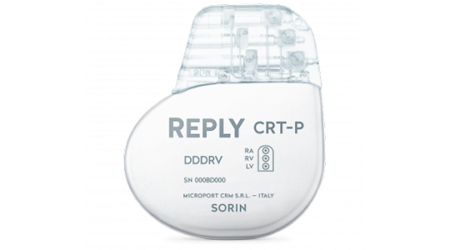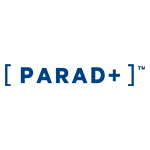TALENTIA 4LV SONR™
Safeguarding your future
Being the longest-lasting 1.5 and 3T full body MRI-conditional CRT-D4, and featuring BlueTooth Low Energya (BLE) connectivity Talentia™ 4LV SonR defibrillators represents Microport® CRM's latest development in the field of cardiac care and heart failure management. Thanks to the SonR technology, the world's only automatic CRT algorithm that is based on cardiac contractility, Talentia 4LV SonR can provide continuous and advanced CRT optimization, improving the clinical outcomes.1,2
AUTOMRI™ adaptive intelligence allows Talentia SonR™ to automatically adapt to the MRI scanning environment, enabling essential therapies to provide a safe MRI pathway for your patients.6
Features
- BlueTooth Low Energy (BLE) connectivity – offers a high-quality connection for a seamless experience.
- Outstanding longevity4 – Protects patients from consequences of avoidable device replacement.5
- AUTOMRI™ – Provides the most appropriate therapy for as long as possible.6
- SonR™– Reduces the risk of heart failure hospitalization by 35% thanks to a CRT optimization automatically tailored to each patient’s need.9-10
- PARAD+™ including the Long Cycle Search – Achieves the lowest rate of inappropriate shocks ever reported in the literature.2,3
- Lead Parameter Evaluation (LPE) – Enhances patient’s protection through earlier lead failure detection and alert.
- BTO™ – Brady Tachy Overlap. Supports patient exercise and detects slow ventricular tachycardia simultaneously.
- WARAD™ – Window of Atrial Rate Acceleration Detection. Accurately detects AF even in case of undersensing using a dynamic atrial window.3
- Multipoint Pacing™ – Captures a broader area of the left ventricle.4
- Remote monitoring with SmartView™ Connect – Offers advanced patient monitoring and follow-up, providing timely alerts and detailed reports.
This product is not available for sale or distribution in the USA. For further information on product availability, please contact your local representative.
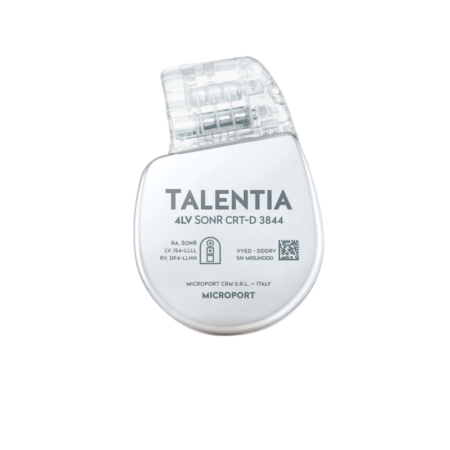
ENERGYA 4LV™
Designed with you in mind
Energya™4LV , the latest Microport® CRM CRT-D, is designed to provide high-standard therapies while making patient management seamless and effortless. Thanks to smart and advanced solutions like AUTOMRI™ and featuring BlueTooth Low Energya (BLE) connectivity, this 1.5 and 3T full body MRI-conditional CRT-D4 device can save valuable time for both healthcare professionals and patients.
Moreover, being the longest-lasting CRT-D device and featuring specific solutions to enhance the specificity of the therapy, Energya 4LV™, guarantees continuous and advanced patient care still making implantation and follow-ups and effortless experience.
Features
- BlueTooth Low Energy (BLE) connectivity – offers a high-quality connection for a seamless experience;
- Outstanding longevity4 – Frees you from early replacements and associated complications.5
- AutoMRI™ – Makes MRI pathway safe for your patients and easy for you.6
- PARAD+™ including the Long Cycle Search – Achieves the lowest rate of inappropriate shocks ever reported in the literature.2,3
- Lead Parameter Evaluation (LPE) – Enhances patient’s protection through earlier lead failure detection and alert.
- BTO™ – Brady Tachy Overlap. Avoids time-wasting parameter conflicts, making programming easier and faster.
- Remote monitoring with SmartView™ Connect – Provides streamlined access to patient information, helping to prevent frequent or unnecessary hospital visits.
This product is not available for sale or distribution in the USA. For further information on product availability, please contact your local representative.
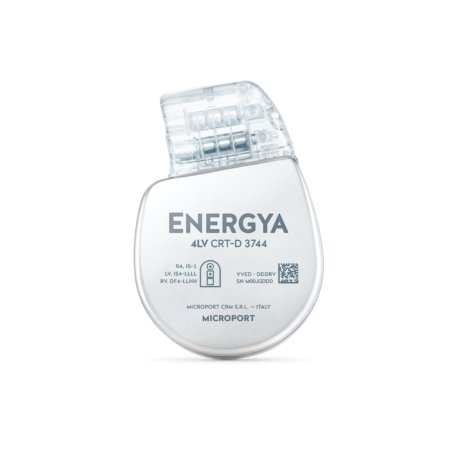
Gali 4LV SonR™
Enhanced intelligence for optimal outcomes
Besides being the longest-lasting 1.5 and 3T full body MRI-conditional CRT-D1,2, Gali 4LV SonR™ features the world's only automatic CRT algorithm that is based on cardiac contractility, enabling it to improve clinical outcomes providing continuous and advanced patient care.3,4
AUTOMRI™ adaptive intelligence allows Gali SonR™ to automatically adapt to the MRI scanning environment, enabling essential therapies to provide a safe MRI pathway for your patients.2
Features
- Outstanding longevity1 – Protects your patients from early replacements and associated complications.5
- AUTOMRI™ – Makes MRI pathway safe for your patients and easy for you.2
- SonRTM – Provides effective, individualized, automatic, and frequent CRT optimization at rest and exercise.4
- PARAD+™ including the Long Cycle Search – Achieves the lowest rate of inappropriate shocks ever reported in literature.6
- BTO™ – Brady Tachy Overlap. Supports patient exercise and detects slow ventricular tachycardia simultaneously.
- WARAD™ – Window of Atrial Rate Acceleration Detection. Accurately detects AF even in case of undersensing using a dynamic atrial window.7
- Multipoint Pacing™ – Captures a broader area of the left ventricle.8
- Remote monitoring with SmartView™ monitor – Offers advanced patient monitoring and follow-up, providing timely alerts and detailed reports.
This product is not available for sale or distribution in the USA. For further information on product availability, please contact your local representative.
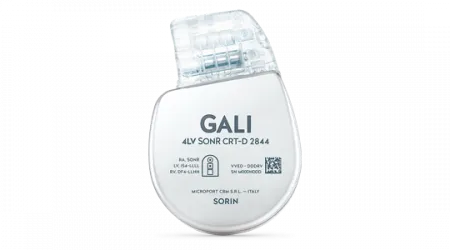
Gali 4LV™
Adaptive technology for streamlined workflow and advanced patient care
Besides being the longest-lasting 1.5 and 3T full body MRI-conditional CRT-D1,2, Gali 4LV™ guarantees continuous, advanced patient care while device dimensions, design and preset programming make implantation, and follow-up effortless.
AUTOMRI™ adaptive intelligence allows Gali™ to automatically adapt to the MRI scanning environment, ensuring that essential therapies are enabled and providing a seamless MRI pathway for your patients.2
Features
- Outstanding longevity1 – Frees you from early replacements and associated complications.3
- AUTOMRI™ – Makes MRI pathway safe for your patients and easy for you.2
- PARAD+™ including the Long Cycle Search – Achieves the lowest rate of inappropriate shocks ever reported in literature.4
- BTO™ – Brady Tachy Overlap. Supports patient exercise and detects slow ventricular tachycardia simultaneously.
- Multipoint Pacing™ – Captures a broader area of the left ventricle.5
- Remote monitoring with SmartView™ monitor – Offers efficient access to patient data that keeps your patients out of hospital.
This product is not available for sale or distribution in the USA. For further information on product availability, please contact your local representative.
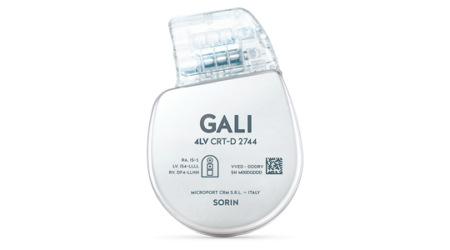
Platinium 4LV SonR™
Gives every patient a chance to become responder
Platinium 4LV SonR™ gives every patient a chance to become a responder thanks to multiple therapeutic options and features the world’s greatest projected longevity.1
Features
- SonR™ – World's only contractility sensor for automatic CRT optimization. 35% risk reduction in heart failure hospitalization.2,3
- PARAD+™ – World’s first dual-chamber arrhythmia discrimination algorithm. Best-in-class 99% overall specificity.4
- BTO™ – Brady Tachy Overlap. Ensures resynchronization whatever the patients condition.
- 14 LV vectors – More LV vectors for flexible pacing.
- Multipoint Pacing™ – Captures a broader area of the left ventricle.5
This product is not available for sale or distribution in the USA. For further information on product availability, please contact your local representative.
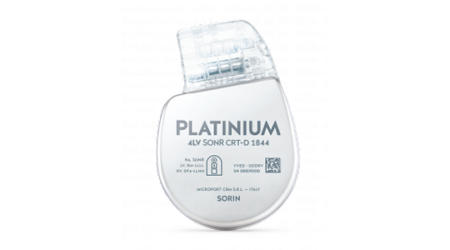
PLATINIUM 4LV™
Featuring the world’s greatest projected longevity1
Platinium 4LV™ is small in design with no compromize on longevity: it features the world's greatest projected longevity.1
Features
- PARAD+™ – World’s first dual-chamber arrhythmia discrimination algorithm. Best-in-class 99% overall specificity.2
- BTO™ – Brady Tachy Overlap. Ensures resynchronization whatever the patients condition.
- 14 LV vectors – More LV vectors for flexible pacing.
- Multipoint Pacing™ – Captures a broader area of the left ventricle.3
Multipoint Pacing™ is not available for sale or distribution in the USA.
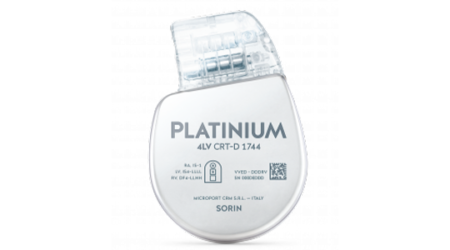
REPLY™
Our groundbreaking research has allowed us to develop the world’s smallest Cardiac Resynchronization Therapy pacemaker.1
Features
- Sleep Apnea MonitoringTM: Early detection, lifetime monitoring. SAM allows you to screen patients for severe sleep apnea as well as monitor the evolution of the disease.
- Dual SensorsTM: Need for accurate Rate Response in CRT. Exercise is proven to have positive effects on mortality, morbidity and quality of life for CRT patients.2,3,4
This product is not available for sale or distribution in the USA. For further information on product availability, please contact your local representative.
